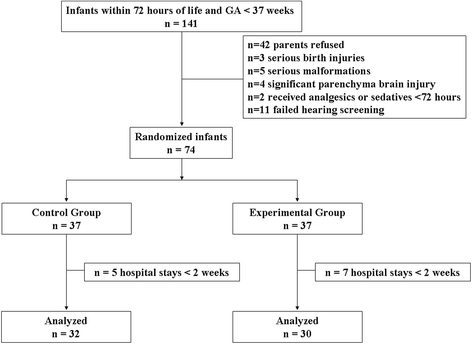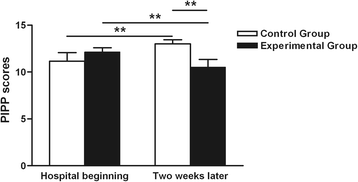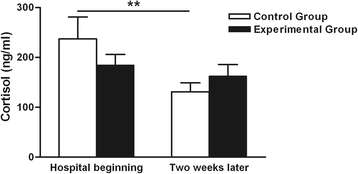Effect of combined music and touch intervention on pain response and β-endorphin and cortisol concentrations in late preterm infants
- PMID: 28125980
- PMCID: PMC5270209
- DOI: 10.1186/s12887-016-0755-y
Effect of combined music and touch intervention on pain response and β-endorphin and cortisol concentrations in late preterm infants
Abstract
Background: Preterm neonates undergo many painful procedures as part of their standard care in the neonatal intensive care unit. However, pain treatment is inadequate in many of these routine procedures. In the present study, we investigated the impact and mechanism of combined music and touch intervention (CMT) on the pain response in premature infants.
Methods: Sixty-two preterm neonates (gestational age of <37 weeks) were randomly assigned to either the experimental or control group. Infants in the experimental group underwent painful procedures with CMT, and those in the control group underwent painful procedures without CMT. Blood samples were collected from all infants at the beginning of hospitalization and 2 weeks later to assess the cortisol and β-endorphin concentrations. Differences in the levels of cortisol and β-endorphin between two groups were examined using analysis of covariance (ANCOVA).
Results: In total, 3707 painful procedures were performed on 62 neonates during their hospitalization. The average number of painful procedures in the control group (n = 35.5) was higher than that in the experimental group (n = 29.0) during hospitalization, although no significant difference was reached (P > 0.05). After 2 weeks, the Premature Infant Pain Profile scores were significantly higher in the control group than experimental group (13.000 ± 0.461 vs 10.500 ± 0.850, respectively; P < 0.05). The cortisol concentration was not significantly different between the control and experimental groups either at the beginning of hospitalization (131.000 ± 18.190 vs 237.200 ± 43.860, respectively; P > 0.05) or 2 weeks later (162.400 ± 23.580 vs 184.600 ± 21.170, respectively; P > 0.05). However, the serum β-endorphin concentration was higher in the experimental group than in the control group both at the beginning of hospitalization (1.640 ± 0.390 vs 1.179 ± 0.090, respectively; P < 0.05) and 2 weeks later (2.290 ± 0.740 vs 1.390 ± 0.410, respectively; P < 0.05).
Conclusions: CMT might decrease the pain response of preterm neonates by significantly improving the β-endorphin concentration, but not the blood cortisol concentration.
Trial registration: Current Controlled Trials ISRCTN14131492 . Registered on 01 Aug 2016.
Keywords: Cortisol; Music; Pain; Preterm infant; Touch; β-Endorphin.
Figures




References
Publication types
MeSH terms
Substances
LinkOut - more resources
Full Text Sources
Other Literature Sources
Medical

